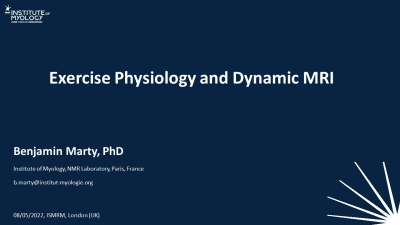Weekend Course
Putting Muscle into MRI of Muscle
Joint Annual Meeting ISMRM-ESMRMB & ISMRT 31st Annual Meeting • 07-12 May 2022 • London, UK

| MRI Muscle I | |||
| 07:45 | MRI Applications in Neuromuscular Disorders
Benjamin Howe
|
||
| 08:10 | MRI Neurography in Neuromuscular Disease
Shivani Ahlawat
|
||
| MRI Muscle II | |||
| 08:35 | Quantitative Muscle Imaging
Hermien Kan
Quantitative MR imaging is usually slower compared to MR conventional imaging, but has the advantage of being more objective, precise and sensitive to detect changes. In this talk I will highlight a number of quantitative MRI techniques that are commonly used in skeletal muscle, along with their accuracy, sensitivity, reproducibility, and relation to a biological property. Quantitative MR of muscles makes use of range of techniques and as pathology is rarely limited to a single feature, there is a strong added value in combining different MR measurements, where assessments are co-localized based on pathology.
|
||
| 09:00 | Proton & Multinuclear Spectroscopy of Muscle
Linda Heskamp
This lecture introduces the basic principles of MR Spectroscopy at a basic level suitable for clinicians with a specific focus on skeletal muscle. Metabolites detectable with 1H MRS, 31P MRS, 13C MRS and 23NA MRS will be discussed together with the software and hardware requirements.
|
||
| 09:25 | Break & Meet the Teachers |
||
| MRI Muscle III | |||
| 09:50 | MRI of Body Composition
Danoob Dalili
|
||
| 10:15 |  |
Morphologic Imaging of the Myotendinous Unit
Jung-Ah Choi
In this presentation, the author will familiarize the audience with anatomy and structure of muscle with emphasis on morphologic MR imaging of normal muscle, as well as MRI of pathologic conditions of muscle, including trauma and non-traumatic lesions, including inflammatory myositis, infectious myositis, rhabdomyolysis, atrophy with fatty infiltrations due to congenital or denervation atrophy. After this talk, the audience should be able to diagnose different pathologies of muscle on morphologic MRI.
|
|
| MRI Muscle IV | |||
| 10:40 |  |
Exercise Physiology & Dynamic MRI
Benjamin Marty
Dynamic magnetic resonance spectroscopy (MRS) and imaging (MRI) techniques are perfectly suited to investigate the physiological adaptation of the skeletal muscle during exercise. The consumption and resynthesis of adenosine triphosphate (ATP), which is the principal high-energy phosphate molecule that enables muscle contraction can be precisely followed using dynamic 31P MRS. Oxygen delivery and extraction, which limit the rate of ATP resynthesis during aerobic exercise can be estimated from the Fick law, using perfusion MRI coupled with susceptometry and/or deoxy-myoglobin 1H MRS. All these valuable data can be recorded at once during the same exercise bout using multinuclear interleaved sequences.
|
|
| MRI Muscle I | |||
| 11:05 | Case Review with Discussion
Darryl Sneag
|
||
The International Society for Magnetic Resonance in Medicine is accredited by the Accreditation Council for Continuing Medical Education to provide continuing medical education for physicians.